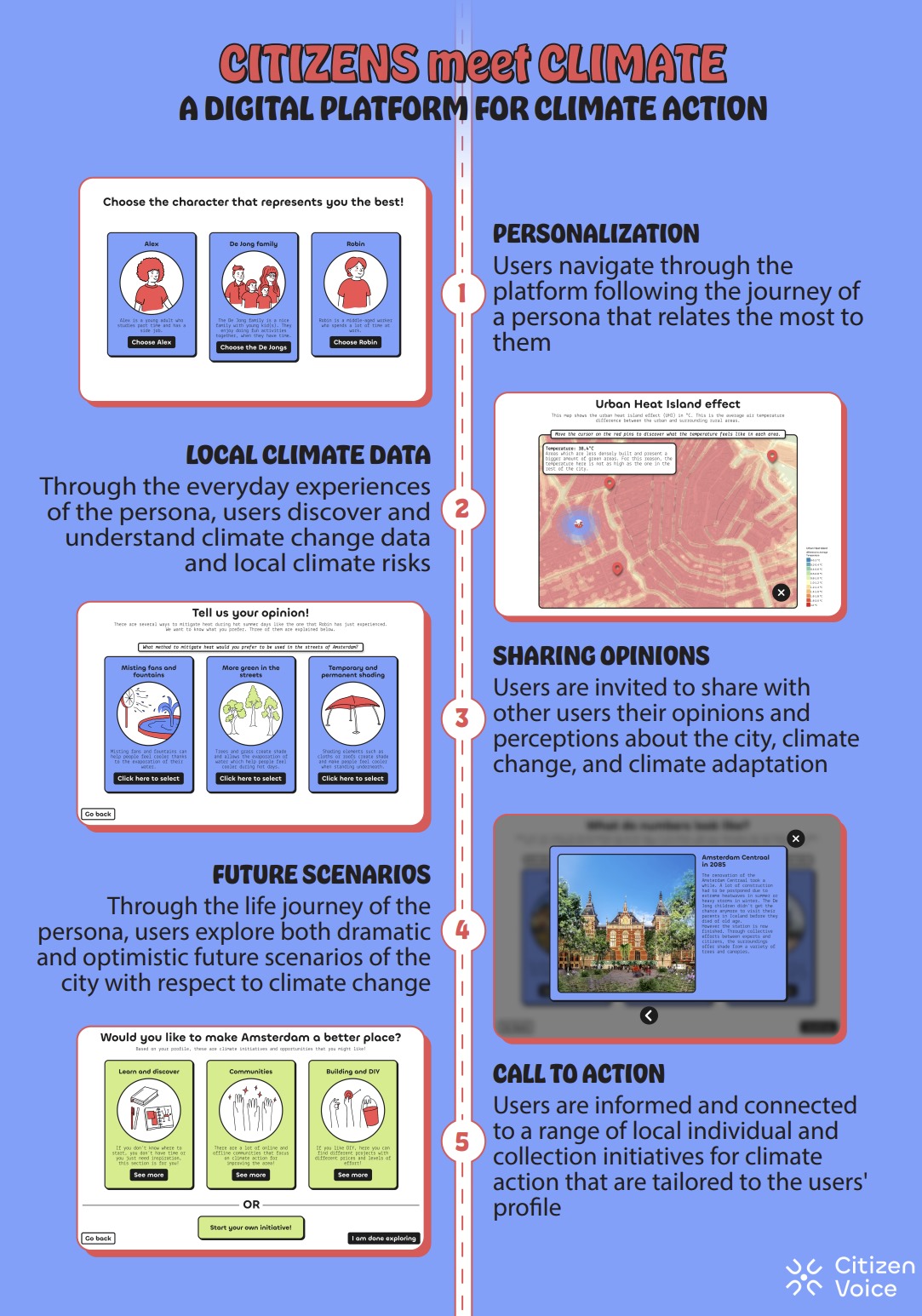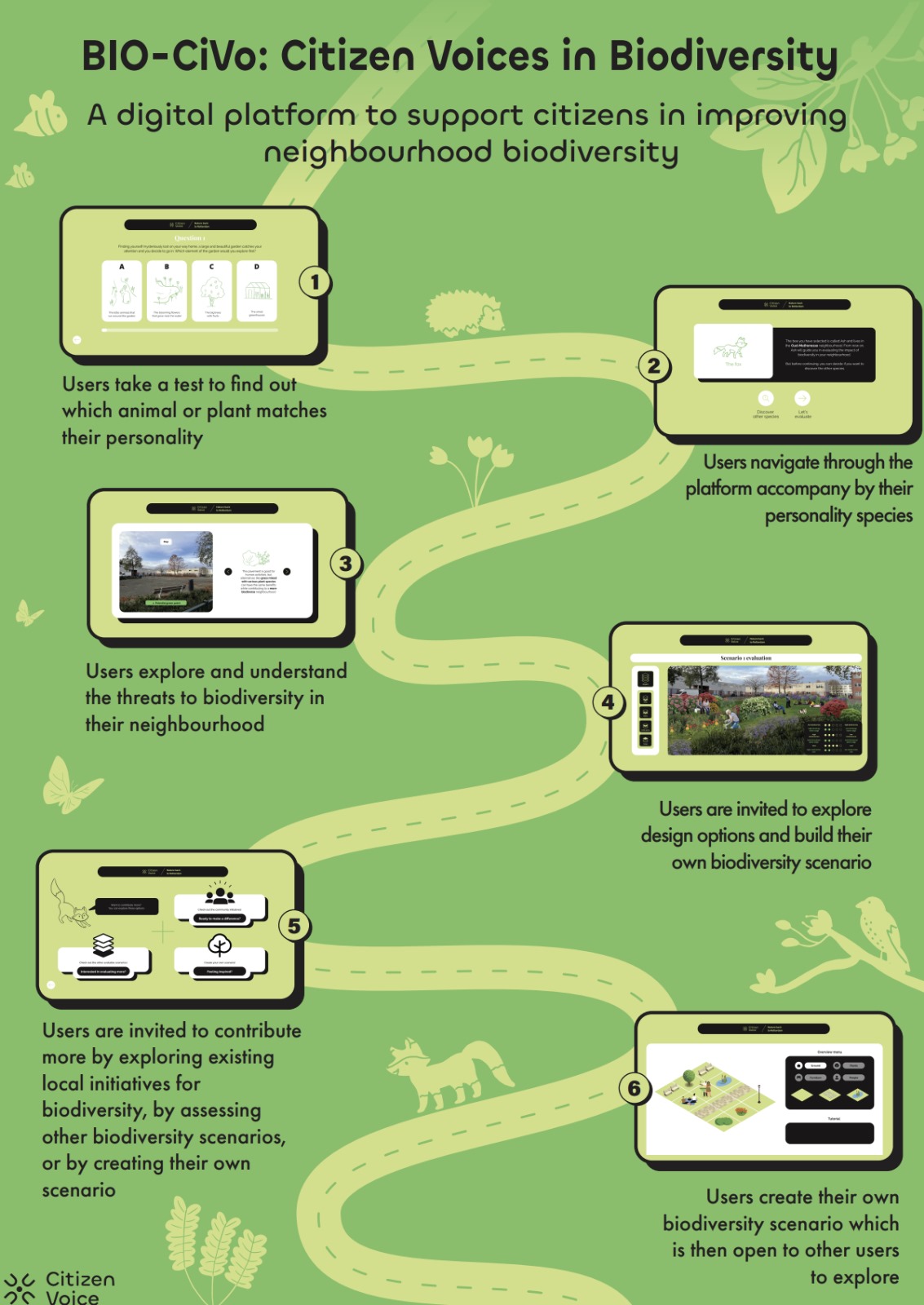Digital tools foster citizen engagement on urban climate action
Citizen engagement is crucial when it comes to the success of urban climate initiatives. While digital platforms are an effective way to enable participation, there are some limitations. Assistant Professors Juliana Gonçalves and Geertje Slingerland are developing tools to overcome these issues, empowering citizens to make a difference with climate change and biodiversity in their own communities.
With around 60% of urban spaces in the Netherlands privately owned, citizen engagement is crucial when it comes to climate mitigation and adaptation activities.
Interface issues
When Gonçalves started exploring ways to facilitate citizen participation in her postdoctoral research, she found that existing commercial tools were not only expensive but also falling short of research needs. That motivated her to create Citizen Voice, an open-source tool that uses digital participatory mapping to enable the collection of spatial information directly from citizens. With shared interests in citizen engagement and urban issues, she connected with Slingerland, who was completing her PhD at the time. Early in their collaboration, the pair recognised that one of their big challenges was the lack of citizen-centric interfaces that would attract participants.
Now assistant professors in the Urbanism department of the Faculty of Architecture and the Built Environment, Gonçalves and Slingerland conducted studies with a user-centric perspective to analyse the interface design of over 10 digital platforms. They aimed to identify design elements that hinder or foster engagement and found three main interface issues: complex navigation, information overload, and limited opportunities for action.
Prototypes with a purpose
With those issues in mind and funding from the Resilient Delta Kick-Start grant and the TU Delft Climate Action programme, the pair set out to develop two prototypes. With the first one, Citizens meet Climate (CmC), Gonçalves says they aim to inform citizens about climate issues in an intuitive way, using storytelling to connect scientific data with peoples’ experiences. Initially, they created a paper prototype, followed by a digital one, and conducted workshops to demonstrate and gather feedback.
We always work like this - we design, we test, and then we redesign and test again.
Juliana Gonçalves
The second prototype, Citizen Voices for Biodiversity (BIO-CiVo), is a spinoff of a Hogeschool Rotterdam and Bioto project that Slingerland participates in called De Wijk als Biotoop (the Neighbourhood as a Biotope). With around 60% of urban spaces in the Netherlands privately owned, citizen engagement is crucial when it comes to climate mitigation and adaptation activities. “We want to study how not only citizens but also other local actors can collaborate to improve biodiversity in their neighbourhoods, explore the role of digital tools in understanding what biodiversity is, and find ways to improve it locally,” says Slingerland. The BIO-CiVo interface offers residents an opportunity to evaluate scenarios, share opinions, and design or propose solutions that could improve biodiversity in their neighbourhood.
We aim to inform citizens about climate issues in an intuitive way, using storytelling to connect scientific data with peoples’ experiences.
Juliana Gonçalves
Lessons learned
The interface prototypes are still a work in progress, but there are lessons learned that continue to help the team. Working on two interfaces has allowed them to build on what they learned with the first prototype. “The framework we created for the climate prototype could be adapted to the biodiversity one,” says Gonçalves. “For example, the approach to define the platform goals and the survey that we use to evaluate the prototypes are very similar. When it comes to testing, we had done it before in a workshop so we know how much time we need, how it goes, and that really makes things much easier.” They had also created a Miro board for the first interface detailing different phases in the project, which the second team could easily follow. On being more efficient, Gonçalves also notes: “It’s important to have continuity of funding to be able to do more than one project and be able to keep our team so that we don’t have to train people all the time. Continuity of funding also means that we can keep the engagement with the communities we work with instead of being a one-off with limited societal impact.”
The team they built also adds value to the project, says Slingerland. “We have an amazing team and I think we work well together. The funding allowed us to hire students that bring different capabilities.” Students from industrial design bring experience with designing interfaces, graphic design, and user testing and urbanism students add spatial, biodiversity, and citizen participation experience. “It's really nice to see how they complement each other and they can really work on different aspects of the project,” says Slingerland.
The funding allowed us to hire students that bring different capabilities.
Geertje Slingerland
Giving back
From a scientific perspective, Gonçalves says they want to understand how people relate to the complex topics of biodiversity and climate change. From a design perspective, they hope to identify the best elements for the interfaces to tell the story. And from a societal perspective, she says: “Our goal is to create something that is useful, that really engages people, and fosters sustainability action that leads to some sort of change.” The team is currently involved in organising a community festival in May with a Rotterdam organisation called Mathenesse aan de Maas that engages citizens on topics like biodiversity. “During the festival people can try out our platform, but there will be also a lot of other activities like greening your neighbourhood,” says Slingerland. “I hope that we will get some direction that we can work on in future research projects, but we also want to give something to the community.”
Gonçalves has been awarded a grant to take the tools to the next level. The project called CIVILIAN will start in May, funded by the NWO Open Science Fund, a funding scheme to support projects that advance open science practices. The team includes Slingerland, Carissa Champlin (IDE), Trivik Verma (TPM), and Manuel Alvarez Garcia (DCC).
CmC student team members:
- Virginia Facciotto (IDE)
- Johanna Zehntner (Urbanism)
BIO-CiVo student team members:
- Jing Spaaij (Urbanism)
- Isabella Jaramillo Diaz (Urbanism)
- Maria Gil Falcon (IDE).



